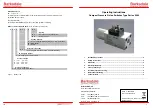
4)
Route redistribution –OSPF can import routing information learned by other routing
protocols or other OSPF processes.
5)
Plaintext authentication and MD5 authentication supported when two neighbor routers in
the same area are performing message interaction, which can improve the security.
6)
Customized configuration of multiple interface parameters, including the interface cost,
the retransmit interval, the transmit delay, the router priority, the router dead time, the hello
interval and authentication key, etc. in order to satisfy multiple network requirements with
flexibility.
7)
Configuration of virtual link – When a network being divided into several areas, it can
connect the areas physically located far away to the backbone network through virtual link.
8)
Configuration of Stub Area and NSSA.
9)
ABR route summarization – to summarize the intra-area routing information with the same
prefix with a single route and then distribute it to other areas.
Configuration Introduction
OSPF protocol defines various parameters to guarantee the normal operation of the OSPF
function. The configurations of all the routers in the AS should be unitedly planned, which adds
complexity to the implement of the OSPF function to some extent. However, in a practical
scenario, most of these parameters need no configurations unless there are special
requirements. Users can keep the default values of these parameters and configure the basic
ones. The necessary steps to configure OSPF protocol is shown below:
1)
Enable routing features on the switches. The routing features are enabled by default.
2)
Create the routing interfaces and configure their IP parameters.
3)
Plan the areas to which the subnets (routing interfaces) of the switches belong.
4)
Configure the OSPF processes on each switch.
5)
Configure the routing interfaces and the areas they belong to under the corresponding
OSPF processes.
The OSPF routing protocol will run normally after the above configurations. A special topology
network requires further reading of introductions to the web configuration pages below to
optimize the corresponding parameters.
218















































